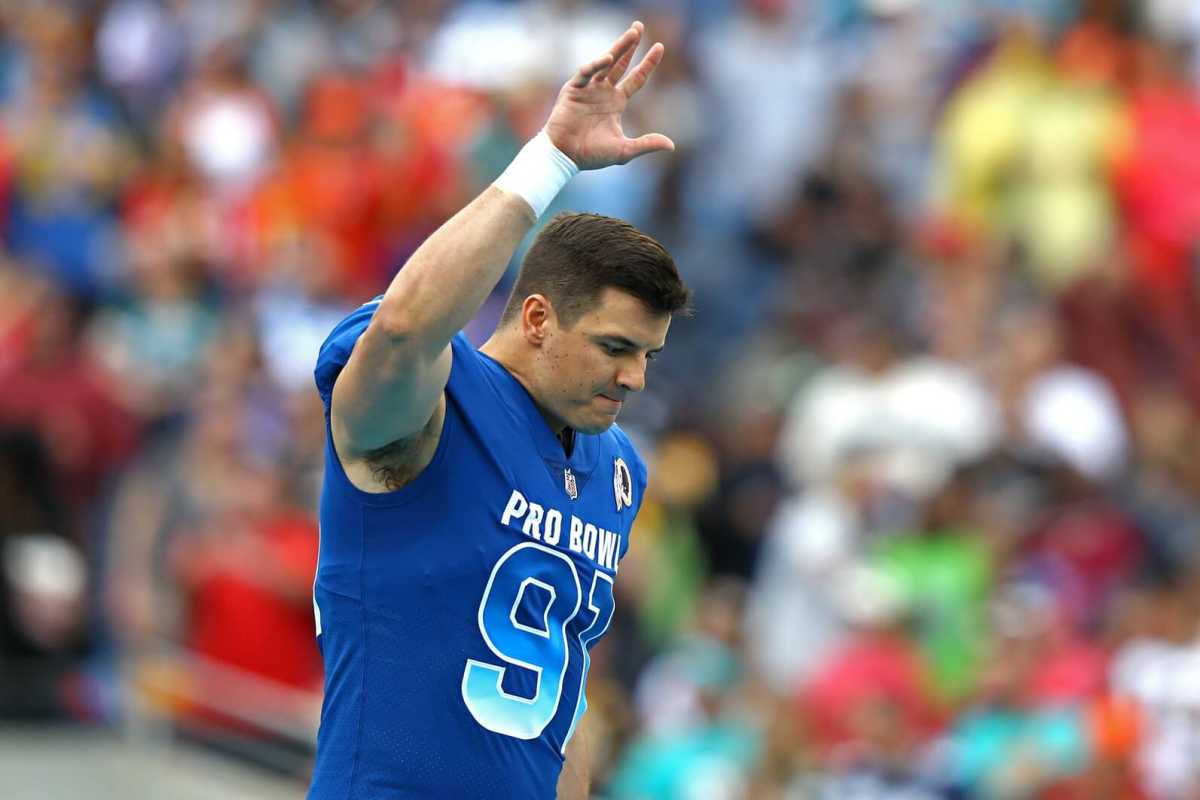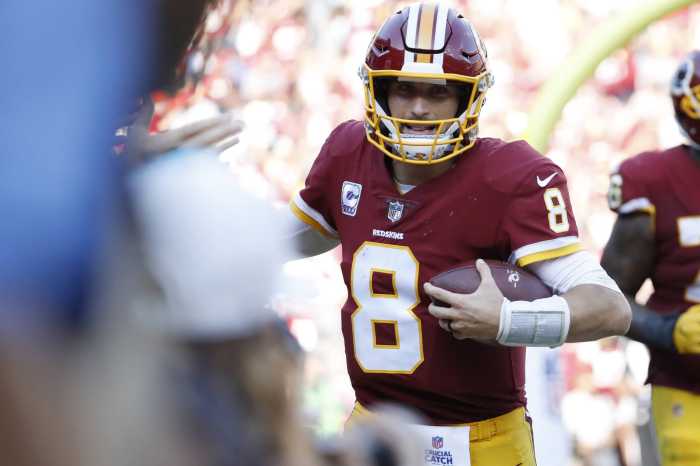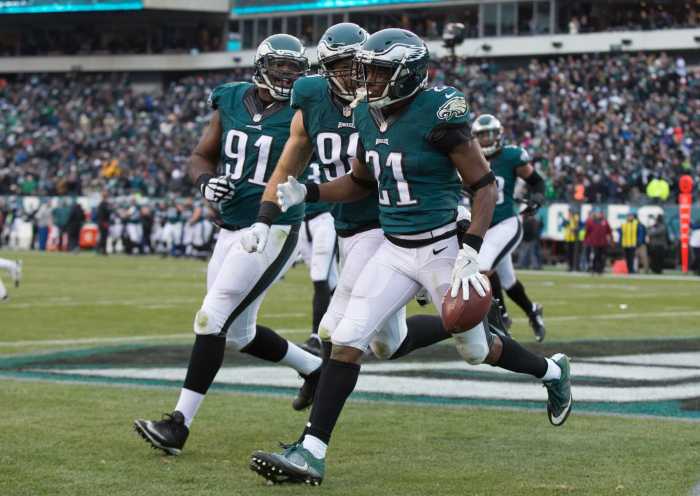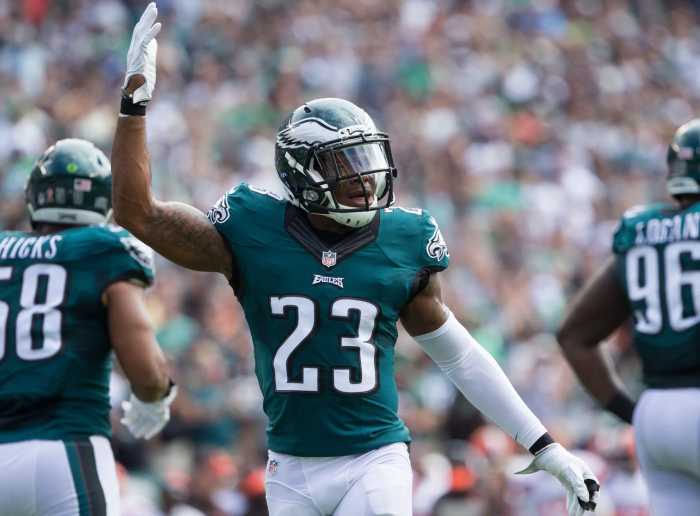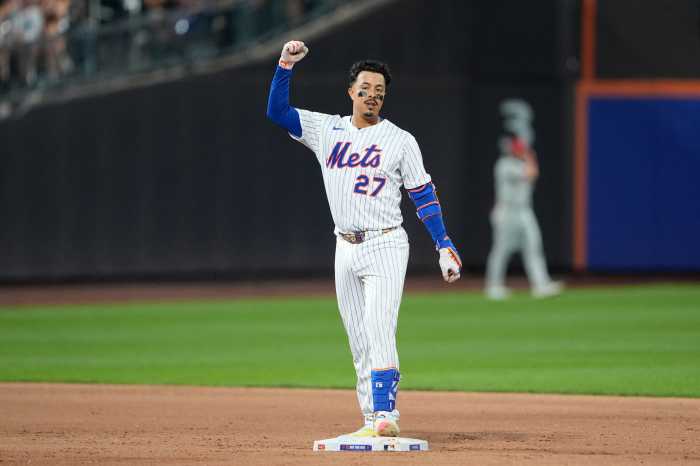Before we begin, let me first grant my sincerest of simpathies to any Redskins fans reading this regarding the unfortunate injury to Derrius Guice. I hope that Samaje Perine or Robert Kelley will undergo a renaissance a-la Nick Foles, and that the rookie has a full and speedy recovery. After the flashes he showed against the Patriots, I truly look forward to seeing him in year two. Let me also address Tim Settle’s fantastic performance – finishing with 5 tackles and looking the part. Last article I mentioned the Redskins’ need for a true nose tackle; it seems as if Settle could become exactly what the doctor ordered. In Eagles news, they played on Thursday for the first time in what seems like an eternity and I’m smitten. It’s back folks – football is back.
Linebackers
Hidden among a disappointing 2017 campaign, the Washington linebacking corps is one of the league’s best groups. Speckled with talent, they are unfortunately at the mercy of the ineptitude surrounding them. Noted in the last article, the Redskins’ defensive line was dismal in 2017. That being said, despite the aptitude and ability of this bunch, the team fielded the league’s worst run defense. Putting things in perspective, the team was 31st in stuffing runs behind the line of scrimmage, 23rd beyond 5 yards, and 16th on runs of more than 10 yards. These statistics correctly point the finger at the Swiss cheese defensive line, while also shining a light on an underwhelming performance by the linebackers. In pass coverage, the Redskins allowed the 4th most yards (970) to tight ends. That was accompanied by 8 touchdowns (tied for 28th) on 127 targets (28th) and 79 receptions (26th). They were much better against running backs, allowing only 585 yards and 4 touchdowns on 77 receptions. After losing some consistent depth players in Will Compton, Trent Murphy and Junior Galette in the off-season, Washington is hopeful that the promising young players they have in tow are ready to make a difference.
Running a 3-4 base defense, Washington requires pass rush ability from their outside backers and physical gap-shooting run-stoppers in the middle. We’ll begin in the middle. Mason Foster returns from injury after being sidelined by a torn labrum in October of last year. Despite the small sample size, Foster was Bleacher Report’s 30th ranked inside linebacker (ILB). He is a terrific run stopper, and his return should immediately improve the Redskins’ woeful run defense. Below, you’ll see his 2016 performance was an impressive indication of the impact he can have over a full season. In the pass game, Foster displays a potpourri of pros and cons.
| Foster | G | Tackles | Solo |
| 2017 | 5 | 31 | 22 |
| 2016 | 16 | 124 | 89 |
Football Outsiders has a fantastic metric for evaluating linebacker efficiency, using stop rate and defeats as a measurement for performance. They define a stop as “any play that stops the offence short of . . . a successful play”. Specifically, a successful play achieves 45% of yards needed on first downs, 60% on second down, and 100% on third or fourth down. Defeats, concurrently, are significant drive altering plays. These definitions will differ from those registered on other football statistics sites such as Pro Football Focus, as the definition of a “successful play” will vary. Below is a definition key for the abbreviations used in the charts to follow. Keep in mind that the player in question will either be the primary target in coverage, or the primary defender involved in the tackle or sack. Therefore, some statistics will skew favorably for pass rushers over cover men.
| PSR = Pass Stop Rate | PSRec = Pass Stop Rate after Reception |
| Y/PP = Average Yards per Pass Play Allowed | YAC = Average Yards Allowed after Reception |
| PSucc = Pass Success Rate | PDfts = Pass Attempt Defeats |
| RSR = Run Stop Rate | Y/RP = Average Yards per Run Play Allowed |
| RDfts = Rush Attempt Defeats |
These numbers are a picture-perfect representation of what Foster brings to the table.
| Foster | PSR | PSRec | Y/PP | YAC | PSucc | PDfts | RSR | Y/RP | RDfts |
| 2017+ | 42% | 30% | 6.5 | 7.0 | 50% | 2 | 79% | 2.6 | 1 |
| 2016 | 42% | 38% | 7.6 | 4.0 | 47% | 9 | 49% | 5.8 | 7 |
+ Played only five games
To help visualize his comparative performance: in 2016 his 47% pass success rate was 45th, his stop rate after completion ranked 56th and yards per reception was 90th of all eligible defenders. An understanding of the middle linebacker’s role in the Redskins’ defense is necessary to completely equate these statistics. For Foster, his 42% pass stop rate is registered mostly in coverage – he is not often asked to rush the passer. That being said, before his injury, he proved to be a very capable rusher last season. In fact, according to Pro Football Focus, he was the number one inside line-backer in terms of pass rush productivity. His numbers probably benefited from limited snaps, but it is still a good indication of what Foster is capable of. As a run stopper, he registered 7 stops in 65 run defending snaps last season according to PFF – ranking him 4th among ILBs on a per snap basis.
Contrary to the inflated 2017 numbers, Foster’s stats earlier in his career are cause for slight concern. His biggest weakness is in coverage. He is not very fast, and will get beat. He recorded only a 27% stop rate against the pass in 2016. The former 3rd-round pick has not been a full-time starter since his second season and was cut by the Bears in 2015. Perhaps he has found his home in the Redskins’ 3-4 defense, or perhaps he will come back down to earth in 2018 following a relatively serious injury.
His partner in the middle is former Buffalo and Tennessee linebacker Zach Brown. After betting on himself last season, he received a 3-year $24 million-dollar contract from Washington this off-season. Brown is a tackle-racking specialist and has the ilk of a hammerhead shark. He is a plus athlete, running a 4.44 second 40-yard dash at the 2012 combine at 6’1” and 250 pounds. After falling out of favor in Tennessee, he came to Buffalo to revitalize his career and hasn’t looked back. Last season he was Bleacher Report’s 7th rated ILB and Athlon Sports’ 9th ranked ILB.
| Year | Games Played | Games Started | Total Tackles (Rank) | Solo Tackles | Sacks |
| 2017 | 13 | 13 | 127 (9th) | 84 | 2.5 |
| 2016 | 16 | 16 | 149 (2nd) | 97 | 4.0 |
| 2015 | 16 | 5 | 77 (75th) | 55 | 0.5 |
| 2013 | 16 | 13 | 91 (61st) | 72 | 4.0 |
| 2012 | 16 | 14 | 93 (67th) | 68 | 5.5 |
*Injured in 2014
There is little question as to Brown’s value between the tackles; however, he has come under scrutiny for what is between his ears. Criticized for his level of competitiveness coming out of college, he has improved, but will still take plays off. It is especially noticeable in coverage. As you’ll see below, he allowed 9.1 yards per pop in pass coverage, a slight decline from the season prior. He is an incredibly reliable tackler – if he can get his hands on his opponent. He is physical enough to win with inside leverage but, despite his speed, he struggles against quicker, shiftier opponents. Last season he looked noticeably slow in coverage. Tracking the ball in the air is not a strong suit. Nonetheless, his speed allows him to be disruptive on screens and quick passes – noted in his 12 pass defeats. Understandably, there have been reports that he could lose passing-down snaps to newly acquired converted-safety Josh Harvey-Clemens, who has impressed this off-season. Harvey-Clemens excels in zone coverage, which might be Brown’s worst facet.
| Brown | PSR | PSRec | Y/PP | YAC | PSucc | PDfts | RSR | Y/RP | RDfts |
| 2017 | 45% | 40% | 9.1 | 4.8 | 50% | 12 | 64% | 3.1 | 14 |
| 2016* | 40% | 31% | 8.4 | 6.8 | 46% | 11 | 66% | 3.7 | 16 |
* With Buffalo Bills
Moreover, again likening him to a hammerhead, Brown is not known around the league as a cerebral player. He is susceptible to roaming, and will get caught out of position. Throughout his career he has been unable to take charge of play-calling, which will prove problematic if Washinton is hit with another season of the injury bug. When taking on blocks, he often leads with his shoulder and neglects his hands, getting him caught up in traffic more often than a run-defender of his caliber should. He makes up for this with sheer power and athleticism, but would make a lot more plays behind the line of scrimmage with some dedication to technique.
The Redskins have some solid depth options in the middle as well. Martrell Spaight returns after being the first ranking inside linebacker in terms of run stop percentage, according to Pro Football Focus. On 178 run snaps, he recorded 41 total tackles (33 solo), 26 run stops (ranked 21st among ILBs) and only missed 5 tackles all season. Zach Vigil was one of the most heavily targeted inside linebackers per coverage snaps last season (1 in every 6.1 coverage snaps) and fared incredibly well, ranking 3rd for his position in passer rating when targeted. According to PFF, he allowed just 149 yards as the primary defender all season.
Finally, Alabama alum Shaun Dion Hamilton will look to make contributions off the bench. Dropping to the 6th round after being half of the best middle linebacking duo in college football in 2016, Hamilton reminded doubters of his pedigree in Thursday’s preseason game, registering ten total tackles (6 solo). Coming off a major ACL injury, there were some concerns as to how he would recover. Being an undersized linebacker that relies on speed and fluidity, worries were legitimate. He did not look constrained in his first action back on the gridiron. A highly intelligent player with physicality to boot, Hamilton plays above his 6’0”, 228-pound frame. He could prove a late round gem and pay dividends early in the season.
Moving to the outside linebacking (OLB) position, where the ‘Skins are loaded as well, Preston Smith and Ryan Kerrigan will look to continue their dominance in 2018. Last season Smith was Athlon Sports’ 8th ranked 3-4 OLB, and Bleacher Report’s 6th. He was also ranked 14th on Bleacher Report’s list of top edge rushers. He has a long, lean frame and makes his money with a combination of a quick first step and an absurd ability to bend around the edge. Last season Smith recorded the highest pressure-rate among defenders with more than 200 pass rush snaps. On 309 pass rush plays, he recorded 8 sacks and a 15.9% pressure rate. He has the ability to drop in coverage, and as you’ll see from the negative yards per pass play result, he more than makes up for his shortcomings in coverage by being a constant threat as a pass rusher. Serviceable as a run defender, you’d like to see him make more defeats. Those numbers will perhaps rise with an improved defensive line this season. At the very least, he does not miss many tackles and closes quickly on the ball.
| Smith | PSR | PSRec | Y/PP | YAC | PSucc | PDfts | RSR | Y/RP | RDfts |
| 2017 | 78% | 33% | -0.6 | 5.8 | 64% | 11 | 70% | 2.0 | 5 |
| 2016 | 80% | 50% | -1.0 | 6.0 | 100% | 10 | 70% | 2.8 | 6 |
In the video I shared last article highlighting Matt Ionnidis, it was hard to take my eyes off of Preston Smith coming off the edge. At 0:25, although he doesn’t secure the sack, you’ll see the patented bend that he is known for when attacking the outside shoulder of opposing tackles.
https://www.youtube.com/watch?v=5d5AMYf9_3w
In fact, securing the sack has been something that alludes Smith. Similar to the criticisms surrounding Brandon Graham in recent years, Smith has had trouble converting consistent pressure into high sack numbers. Suspect one is the defensive line, however consistency has been an issue for the OLB. He will have stretches of games with less-then-productive numbers. Similar to Zach Brown, he will drift away from his assignment and can get caught looking in the backfield. He will need to become more disciplined. Perhaps pernicious to his development, Smith is often able to compensate with freakish athleticism. The video below is a fantastic example of his physical ability. A strong initial punch allows him to keep the tackle at arm’s length and read Eli’s eyes to make the interception – a pretty impressive play in and of itself.
This being a contract year, Smith will be looking to secure a hefty contract similar to the five-year $72 million deal the Vikings gave to Danielle Hunter. The two ‘backers have very similar numbers over their career. In 3 years, Smith has pegged 115 total tackles, 20.5 sacks, 10 passes defensed, three interceptions and four forced fumbles.
His edge rushing partner is possibly the most underappreciated pass rusher in the league. The three-time Pro Bowler Ryan Kerrigan has been wreaking havoc in opposing backfields since he entered the league in 2011. In that span he was a top-15 pass rusher in five of seven seasons and a top-five pass rusher in three, while not missing a single game. He is a high effort, high energy player with a lightning-quick first step and a nasty inside counter move. Kerrigan’s arsenal of pass rush moves is stocked full. Despite hanging his hat on speed, Kerrigan will catch opposing lineman napping with a surprisingly strong bull rush. At 6’4” 259 pounds, he is no small man.
The image above likens Kerrigan’s performance to that of his draft class counterparts. The results are especially impressive when considering who else was drafted in 2011: names like Von Miller, Cameron Jordan, Aldon Smith, J.J. Watt and Cam Hayward. Over the last 4 seasons, only Von Miller has registered more sacks than Kerrigan’s 47.0.
| Kerri | PSR | PSRec | Y/PP | YAC | PSucc | PDfts | RSR | Y/RP | RDfts |
| 2017 | 84% | 0% | -3.5 | 11.3 | 22% | 16 | 85% | 1.9 | 5 |
| 2016 | 100% | 0% | -5.7 | — | — | 12 | 84% | 1.3 | 7 |
This chart primarily denotes his efficiency in run stopping – registering an 89% run stop rate and 1.2 yards allowed per run play in 2015. It also alludes to the rarity of the coaching staff asking him to drop in coverage. Not to say that he isn’t capable of hanging with tight ends and running backs, nevertheless, Washington are at their best with Kerrigan chasing the quarterback.
With regard to depth, Washington made a key signing in the off season, bringing in Pernell McPhee from Chicago. McPhee hasn’t had a fully healthy season in three years and has never started more than 12 games in a season, but can be incredibly efficient as a situational pass rusher. Despite only starting in five games last season, he was the 13th ranked 3-4 OLB by Pro Football Focus and the 26th 3-4 OLB according to Bleacher Report. This is a tribute to his 14 sacks over 36 games in the last three seasons despite never being a full-time starter. His time with the Bears came to an end due to his concerning injury history and a bloated contract – not his talent. Although, as the old adage goes: the best ability is availability. McPhee will never be a top-level run stopper, and should not be counted upon to routinely drop in coverage. His key attribute for this defense is versatility: he has played 3-4 end, nose tackle and edge rusher in his career.
| McPhe | PSR | PSRec | Y/PP | YAC | PSucc | PDfts | RSR | Y/RP | RDfts |
| 2017* | 82% | 60% | -0.2 | 1.0 | 90% | 7 | 69% | 4.1 | 1 |
| 2016*+ | 100% | 0% | -9.8 | — | — | 4 | 75% | 2.8 | 3 |
* With Chicago Bears + Played only nine games
Below is a fantastic 12-minute breakdown of McPhee’s game, however I would like to draw your attention to some specific plays. At 0:14 and 4:37, he puts his bull rush on display, knocking the opposing tackle flat on his backside. Lining up as a standing rusher, something he will do a lot of in Washington, he easily beats the tackle with a quick first step and good hand technique at 1:23 and 6:45.
The Redskins will also be hoping for a solid contribution from last year’s second-round pick Orlando “Ryan” Anderson. Last season was not the rookie season Anderson was hoping for. Bleacher Report ranked him the 115th edge rusher, and 40th 3-4 outside linebacker in the league. He did not appear to be the imposing pass rusher he was in college and was clearly lacking the strength to take on NFL-caliber lineman. He will have to hone his moves in order to use his speed to his advantage. He is a dependable, but not game-changing run stopper.
Best Case: In both scenario’s the true floor and ceiling of this group will be determined by the three big men up front. Even without a productive contribution from the defensive line, the starters were effective in putting the pressure on all season in 2017. The big leaps and bounds will be seen in run stopping. The team will see quick improvements if Zach Brown and Preston Smith are able to whet their positional efficiency, and become more consistent contributors. Ryan Kerrigan has become an all but proven entity and should continue to produce at a high level. Washington has added players that should help in coverage and limit yards allowed to tight ends. Depth and youth should lessen the detriment of possible injuries. It’s a reach, but on paper, this group could be in the top 5 – especially with Kansas City changing pieces and Seattle and Denver not looking the same teams as in past years.
Worst Case: Last season was proof that in spite of all the talent this group has to offer, they cannot be a top defense without a steady defensive line. It can’t get worse than the worst run defense in the league. On the opposite side of the coin, Washington may be dependent on the pass coverage skills of some pretty young and unproven players if Zach Brown cannot improve. 120 tackles mean nothing if Brown can’t start making more plays behind the line to gain. Kerrigan should register double digit sacks regardless of the defensive line situation. Solely based on his inconsistency, Preston Smith could have a significantly worse year in 2018 – such is the nature of inconsonance. This could be a telling year for Mason Foster after looking promising before injury in 2017. Either he will appear to have not missed a step, or prove that his 2016 season was his peak.
Mandatory Credit: Aaron Doster-USA TODAY Sports

